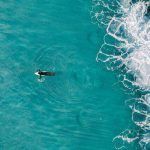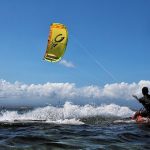In bodyboarding, the surfer rides a short, rectangular board made of hydrodynamic foam on the crest, face, and curl of a wave heading towards the shore.
The surfer may also wear swim fins for additional propulsion and control. The sport was invented in 1971 by Tom Morey, who also coined the term “Boogieboarding.”
What is Bodyboarding?
Though it is sometimes referred to as an easier alternative to surfing, bodyboarding is distinguished from surfing by the fact that participants ride the waves in a prone position, with their torsos pressed against the surface of the board.
The name “bodyboarding” derives from this posture (though it should be noted that tricks which involve partially standing on the board, or even fully standing, are commonplace in competitive bodyboarding).
Origin
Bodyboarding began as a way of riding waves on one’s stomach, which originated from an ancient form of surfing. Indigenous Polynesians rode “alaia” boards on their belly, knees, or feet (in rare instances), and these boards were generally made from the wood of Acacia koa.
Alaia boards differed from modern stand-up surfboards in that they had no ventral fins. Captain Cook recorded seeing Hawaiian villagers riding such boards when he came to Hawaii in 1778.
This occurred in the late 1950s or early 1960s. He saw people riding boards that were 3 to 6 feet long, either lying down or kneeling. These evolved into the more modern “paipo” boards, which were made of wood or fiberglass.
The fiberglass boards usually had fins on the bottom. Tom Morey combined this type of surfing with his work of shaping boards for people to stand on, in the late 1950s or early 1960s.
Different Riding forms
There are three main ways to ride a bodyboard, which are determined by the rider’s personal preferences, such as height, weight, and form of riding. The three ways to ride a bodyboard are prone, dropknee, and stand-up.
Prone
Riding prone means that the bodyboarder is lying on their stomach on the board as they ride the wave. To turn left, the bodyboarder would place their left hand on the upper left corner of the nose, and their right arm halfway down the rail of the right side of the board.
The opposite is true for turning right.
Dropknee
The surfing stance known as dropknee is performed by placing the front foot’s fin on the front of the board, and the rear foot’s knee on the bottom end of the board, with the fin dragging in the water. This stance was first pioneered in the late 1970s by Hawaii’s Jack “The Ripper” Lindholm. It is sometimes referred to as “Jack Stance”.
Unlike the fiberglass stand-up surfboards used by most surfers, the bodyboards used by dropknee riders do not have fins underneath. This lack of fins makes it harder for the rider to maintain a line on the face of a wave or to stop them sliding out.
Dropknee riders must rely on weight transition from rail to rail to hold a line on a wave and turn/snap. On the other hand, the benefit of not having fins underneath the board is that a rider can spin 360 (forward and reverse).
Stand-up
Stand-up surfing is less popular than the other two forms of riding a bodyboard, but three notable figures that popularized it are Danny Kim, Cavin Yap, and Chris Won Taloa.
The board
Materials
Polystyrene (Styrofoam) cores are suited for all water temperatures due to their stiffness and durability. Bodyboards are much shorter than surfboards, typically 100 to 110 cm (39 to 43 in) in length, and are made out of different types of foam.
The modern board consists of a foam ‘core’ encapsulated by a plastic bottom, a softer foam top known as the deck, and softer foam sides known as the rails. The core is made of dow/polyethylene, arcel, polystyrene, or Polypro/polypropylene. The bottom is made of Surlyn, HDPE or Bixby. The deck is made of 8LB or CrossLink.
Each type of foam core, deck, or bottom material gives a bodyboard a different amount of flex and control. Speed from the bottom turn is increased when a bodyboarder bottom turns and the board flexes and recoils, releasing energy.
If the board flexes too little or too easily, speed is lost. Dow (polyethylene) cores are best suited to cooler waters as they can be too flexible in warm water. Arcel and Polypro (polypropylene) cores are best suited for warmer waters
There are usually one, two, or three rods running parallel to the rails on most boards on the market today, which are referred to as stringers. They are placed in the center of the board if there is only one, symmetrically about the y-axis if there are two, or a combination of the placement of both a single and double stringer if there are three.
These stringers strengthen the board, reduce deformation, add stiffness and recoil to the core, thus providing greater speed off bottom turns and transitions on the wave.
Construction
The deck, rails, and bottom are bonded to the core using various hot air lamination techniques. Shapers used to accomplish this by using glue.
Features
The way the board is curved affects how it rides. If the widest part of the board is closer to the nose, it is usually best for prone riding, because the bodyboarder’s weight is further forward on the board.
Boards that have more parallel sides or a narrower nose are usually better for drop-knee and stand-up riding, because the rider’s center of gravity is further back.
Most modern boards are equipped with channels which increase the surface area on the board. This allows the board to have more control on the wave. Skegs were originally installed to help with slippage on waves.
However, progressive bodyboarding has made them obsolete because they are not needed for maneuverability. For this reason, skegs are not used much anymore and are only used by dropknee or stand-up bodyboarders.
The shape of the tail affects how a board performs in the lineup. A crescent-shaped tail provides more hold in steep waves and is preferred by drop-knee riders because it doesn’t get in the way as much.
Beginners also tend to prefer crescent tails because they work well in different types of conditions. Bat-shaped tails provide more flexibility for transitions from one rail to the other and are preferred by prone riders more than drop-knee riders.
Benefits of Bodyboarding
Develops your arm and leg muscles
Bodyboarders who have been doing this for a while can tell you that most of the time you spend in this sport is paddling and kicking. Because you spend so much time just paddling to catch a wave, your arm and leg muscles will get stronger.
Strengthens your heart and lungs
Any water sport is generally considered to be a great cardio workout, and bodyboarding is no different!
Bodyboarding builds up coordination
Keeping yourself centered and balanced while on your board is one of the basics of bodyboarding. With you constantly trying not to fall off the board, your coordination will surely improve over time.
Relaxes the mind
There’s nothing quite like bodyboarding on the warm sun and the calming sea to help you relax.
Offers a ton of fun!
The reason bodyboarders keep coming back to this sport is because it’s enjoyable. That’s all that needs to be said.
Bodyboarding 101
Make sure you’re fully prepared
It’s okay to be excited about bodyboarding for the first time, but you should be aware of a few things before you get on the water.
What are the sea conditions?
Make sure to check in with your local coast guard or tune into local news before heading to the nearest bodyboard area to see if the sea conditions are safe.
Are you a good swimmer?
You should know how to swim in open water.
Do you have the right gear?
All you need to start bodyboarding is a bodyboard, and here are three other things you’ll need:
Leash
You should get a leash that attaches to your bodyboard and your upper arm to make sure you don’t lose your board when you wipe out.
Wetsuits or Rash Guards
Bodyboarding, like all other watersports, exposes you to harsh environments. Wearing the right body protection gear, such as a wetsuit or rash guard, protects you from the sun and lessens irritations from the bodyboard.
A wetsuit or rash guard will also keep you warm when you’re riding on cold water.
Fins
Bodyboarders usually wear fins on their feet for extra propulsion while catching waves. It is also recommended that they wear fin socks under their fins for extra comfort.
Practice your positions
Before jumping into the water, it’s a good idea to practice your positions on land. The ideal bodyboarding position is to hold onto the nose of the board with both hands, with the tail positioned under your lower belly.
You can practise your paddling by kicking your feet while you are getting ready to go into the water. Once you are in the water, you can try paddling your feet just below the water’s surface to make sure you have better propulsion.
When you are paddling with your arms, paddle on the side of the bodyboard as if you are pulling the water behind you.
Getting into the water
You can start bodyboarding once you are confident with your practice. Go to the water until it is knee deep. Then, rest on your bodyboard and start paddling towards the waves.
However, only go for whitewater waves that are headed in the direction of the beach.
Catching a wave
Put your knowledge to the test as you go out to your wave. You should make sure that the wave you chose is not too high or too fast, especially if you are just starting the sport. Find a wave that is comfortable for you to start with, you’ll have time to try out harder ones later.
After you have found a good spot for the waves, start paddling in that direction using your arms and legs like you did during practice.
Practice Duck Diving
If you’re bodyboarding and a broken wave is headed towards you, duck diving can help you stay on track. Duck diving is when you dive under a wave for a moment.
Because bodyboards are small and lightweight, you can easily push them under the water using your body force.
Getting close to the wave
Once you’ve finally gotten close enough to the wave you want to catch, you’ll need to turn around quickly and face the beach. Remember that you should try to catch the wave while it’s high enough to carry you forward, but not so high that it’s about to break (or where there’s a lot of white water).
You should paddle towards the beach as quickly as possible until you feel the wave begin to push you forward. Once you’re caught in the wave, you’ll start moving more quickly, and this is when you can ride the wave.
Riding the wave
This means you create a line across the face of the wave by “trimming” it. You do this by moving your bodyboard to the left or right using your body weight to press down on the side of the bodyboard.
If you’re just starting to bodyboard, I recommend sticking to the basic position you practiced while going down the wave. For extra speed, you can try pushing down lightly on the nose of your board.
If you’re going too fast, you can lift the nose of the board a few inches out of the water to create friction and slow down.
After riding a wave and reaching the shallow part of the water, you may want to take a break or try again. Be aware that it can be addicting to ride your first wave, so be sure to give yourself a break occasionally.



